JARS v64n1 - The Importance of Collections and the Dietrich Hobbie Species
The Importance of Collections and the Dietrich Hobbie Species
Gerald Dixon
Shute, Devon, UK
Reprinted with the kind permission of the editor of Rhododendrons, Camellias and Magnolias , 2009: 66-73Thanks to the great efforts of plantsmen such as Peter Cox, Kenneth Cox, Alan Clark and others, we have recently become used to a continuous influx of ever more rhododendron species. Some of these are completely new introductions but there are also many "new" forms of established species, often collected from different altitudes and geographical areas, which provide a necessary variation to the forms already in our gardens.
Even more important to the gardener, however, are the specialist nurseries like Glendoick, Millais, Hydon and others, who do so much to ensure the general availability of these new plants. Only after many years of careful propagation and generous distribution is it possible for the general public to enjoy the fruits of this process.
Whilst we are very fortunate to have great parks like Windsor, the National Trust properties and gardens such as Glendoick, where many validated forms can be seen, such collections are nevertheless rare in the UK and, perhaps understandably, less and less notice is being paid to the myriad of "old" species and their selected forms. The importance of these collections, with their ability to contain a representative record of past developments by combining the work of the plant hunters with that of the nurserymen, is vastly understated.
Even if such collections are becoming thin on the ground in the UK, there are many excellent species collections on the European Mainland. A good example is that of the western part of Germany where most medium-sized towns and virtually all the main cities have their own botanical gardens. Perhaps these are in similar ratio to town size as our own public gardens and communal parks but there is one important difference: the German gardens almost always feature rhododendron species to some extent.
At first I was somewhat puzzled as to why, in a climate much harsher than the UK, so much reliance was placed on these plants in particular. The simple answer is that these collections are a product of both the lifework of Dietrich Hobbie, certainly one of the most influential rhododendron experts of the last century, and to the subsequent work of the German specialist nurserymen.
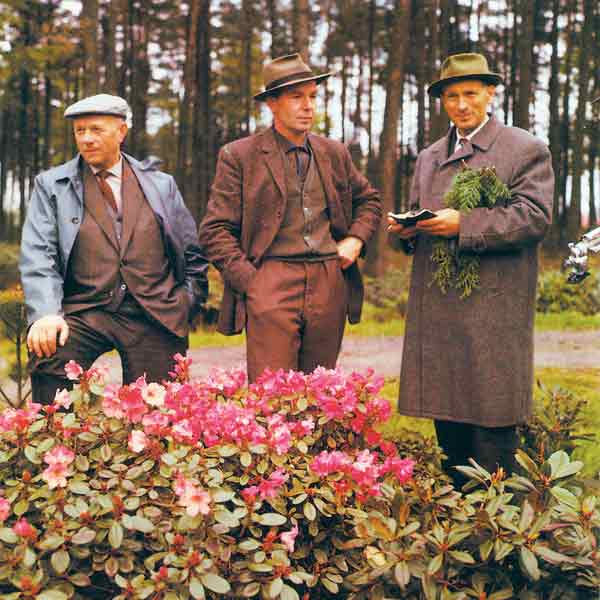
|
|---|
Fig. 1: Dietrich Hobbie, Hans Robenek and Johann-Diedrich Zu Jeddeloh in the Hobbie Park c. late 1950s. Photo by Heinz Drath |
Dietrich Hobbie was born in 1899 into an agricultural family that had farmed a large area of land around Linswege since early in the 12th century. He was formally educated in agriculture and forestry before taking over the family business from his parents. It was whilst discussing possible uses for a large woodland area that his neighbour, G.D. Boehlje, suggested that Hobbie plant a crop of rhododendron seedlings. The high shade of the pines and the peaty ground with its deep covering of rotted needles provided ideal conditions for the young rhododendrons. This initial successful sowing of Rhododendron catawbiense and R. luteum seed provided the spark for what was to be a lifelong involvement with rhododendrons.
These first efforts were followed in the coming years by the inclusion of more and more species and in 1936 Hobbie, through his contacts with Sir William Wright Smith of the RBG Edinburgh, managed to obtain seeds of twelve species, collected by Frank Kingdon Ward during his 1935 Tibet expedition. These included R. fulgens and R. wallichii . A year later, in 1937, he was able to plant 120 seed lots and in 1938 over 270 seed lots, many from Professor Hu's expeditions to Yunnan and Sichuan which included several hardy forms of R. vernicosum . To give an impression of the scale of Hobbie's work, in an article written 20 years later he talks of "more than ten-thousand plants from Prof. Hu's collections thriving in his woodland, some over 2 metres high."
In 1939 he was able to sow over 300 different seed lots including the important collections from the Ludlow, Sherriff & Taylor 1938 expedition to southeast Tibet. Sadly, the Second World War brought an interruption to Hobbie's Edinburgh connections but by now he was growing more than 200 different wild-collected species, tens of thousands of plants spread over six hectares of pine woodland. By the early 1950s Hobbie was starting to distribute many of these seedlings to Germany's city parks and botanic gardens. Until this time virtually all species were produced from seed. Attempts had been made to graft the best forms on to R. catawbiense seedlings that had been grown in their own woodlands, but there were obvious problems of compatibility with a number of species and the uneven vigour of the understocks gave very unreliable long term results. Thanks to the subsequent influence of Hans Robenek, Hobbie's Head Gardener, grafts were tried on understocks of R. 'Cunningham's White', grown as two-year old rooted cuttings. In these days before the general availability of thin polythene, very few elepidote varieties were produced from cuttings, but R. 'Cunningham's White' proved to be easily rooted. More importantly, it was also shown to be widely compatible with many of the more difficult species, and the resulting plants were much less prone to the various diseases and growth problems associated with the R. catawbiense understocks.
Thanks to this development, many of the tougher and most attractive forms of the wild-collected species seedlings were widely distributed, many to local authorities in western Germany but also to Holland and Scandinavia. Thus it is today that many of these forms are distinguished by prefixing their name by the name of the garden or park in which they grow.
The following are short descriptions of some of the outstanding forms that Hobbie selected and which are generally available today:
R. adenogynum (Taliensia). A compact medium-sized bush, not much more than one metre in 20 years. The main attraction is the dense dark green foliage with a thick olive-brown indumentum but also the relatively freely produced white to pink flowers with reddish spotting. This plant was initially known to Hobbie as R. adenophorum , most probably raised from Yu 14955. Tough and hardy, to be found in all the main Botanic Gardens.
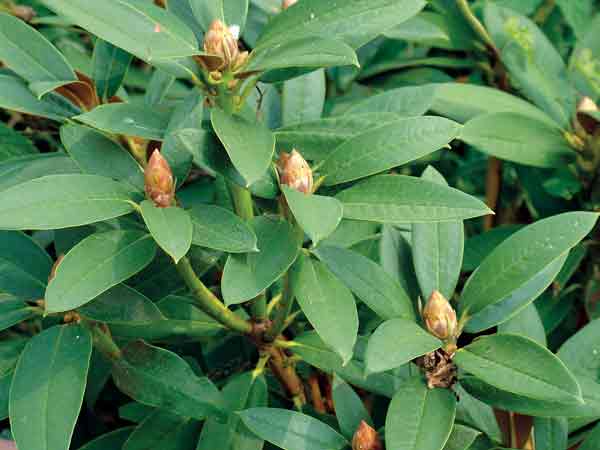
|
|---|
Fig. 2: Rhododendron adenogynum Photo by Gerald Dixon |
R. argyrophyllum (Argyrophylla). A stiff-branched shrub with icing-sugar pink funnel-shaped flowers in loose trusses. There is a large thicket of this species in the Rombergpark in Dortmund, presumably some of the original wild-collected seedlings grown from the Hu collections. In the Forstbotanishe Garten in Bonn there are two plants labelled with this name which seem very close to R. pingianum .
R. balfourianum (Taliensia). Rather lax trusses of pink funnel-campanulate flowers on a close-growing compact bush. Foliage with shiny grey indumentum. Hobbie considered this plant to be R. adenogynum and it was probably a seedling from Yu 14662. When I gave a small plant (30cm high and already flowering) to Ted Millais in the early 1980s he recognized it as being R. balfourianum . A large specimen can be seen in Moenchengladbach's "Bunte Garten."

|
|---|
Fig. 3: Rhododendron balfourianum Photo by Gerald Dixon |
R. bureavii (Taliensia). Velvety orange-red indumentum on leaves and shoots. A compact bush with pale pink flowers flushed red. Hobbie was given the original plant by Lionel de Rothschild and later distributed hand-pollinated seedlings. The most beautiful of these we call 'Gruga', named after a park in Essen where the form was grown.
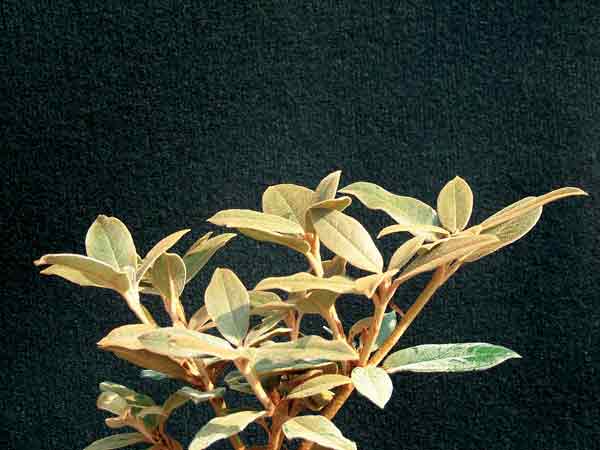
|
|---|
Fig. 4: Rhododendron bureavii 'Gruga' Photo by Gerald Dixon |
R. campanulatum (Campanulata). Glossy dark green leaves on a compact, slow-growing bush. The foliage is smaller than the usual UK selections and is very neat. A particularly good form is grown in Bonn's "Forstbotanische Garten": it has very pleasant lilac-blue flowers which appear on relatively young plants. Hobbie also grew a few forms of R. campanulatum ssp. aeruginosum , again very neat, compact plants mainly grown for their foliage. The best form has beautiful steely blue new growth lasting over three weeks.
R. decorum (Fortunea). Wonderfully scented white flowers on an upright bush. This form is very hardy, quite slow-growing, eventually becoming a stout branched medium-sized shrub with very neat foliage. The flowers are somewhat smaller than in some of the UK forms but it makes up for this by being reliably free-flowering. A good sized specimen grows in the "Rombergpark" in Dortmund.

|
|---|
Fig. 5: Rhododendron decorum Photo by Gerald Dixon |
R. degronianum ssp. heptamerum (Pontica). This form was known to Hobbie as 'Metternianum'. The growth is more compact with smaller, re-curved leaves and darker rose coloured flowers than in most other forms. The plant was used by Hobbie in many of his crosses and is very tough. A large example still grows in The Hobbie Park in Linswege.
R. degronianum ssp. yakushimanum (Pontica). Hobbie received wild collected seeds of this species from the Japanese botanist Dr. Rokuju, collected from different areas of Yakushima. He crossed two of the best of these seedlings to produce a form he called 'Hana No Ego'. It has shorter, narrower foliage than the FCC form, flowering about two weeks later. The heavily indumented new growth is attractive over a very long period and the bush is much lower growing. We have a number of plants of this form growing in our nursery, now more than 25 years old and still only about 60 cm (two feet) high.
R. x erythrocalyx (Selensia/Campylocarpa). Presumed to be a natural hybrid between R. selense and R. wardii , this form was selected by Hobbie for its beautiful cream-coloured flowers with a dramatic red flare and its vigorous growth. It eventually becomes a medium-sized wide-growing bush with lovely bold foliage. The original plant can still be found in the Hobbie Park.
R. floribundum (Argyrophylla). An upright bush with stiff floccose branches and large, bullate foliage. This form can become quite chlorotic if not adequately fed but is otherwise very robust and easy to grow. Larger, wider foliage than most UK forms. A pair of large examples are grown in the "Bunte Garten" in Moenchengladbach.

|
|---|
Fig. 6: Rhododendron floribundum Photo by Gerald Dixon |
R. fortunei (Fortunea). Beautiful heavily scented flowers on a wide-growing bush with attractive light green foliage. This is a very hardy and dependable form selected by Hobbie, with lilac-rose, strongly scented flowers produced in abundance. The original plant, now a tree at least eight metres high and wide, is a main attraction in the Hobbie Park.
R. fulgens (Fulgensia). A very compact, medium-sized shrub with beautifully glaucous stems and neat oval foliage. The new growth is particularly attractive, nearly as blue as R. campanulatum ssp. aeruginosum . Hobbie referred to this as the 'Kingdon Ward Form', presumably sown as KW 11587 in 1936. Rather shy flowering, nicely shaped bushes can be seen in the Rhododendronpark in Bremen.
R. hobbiense (Lanata). A medium sized stiff-branched shrub with dark green leaves bearing a thick olive-green indumentum. This plant was distributed for many years as "R. bureavii aff. Hobbie" and was considered by some experts to be a form of R. tsariense Poluninii Group. It has recently been described by the Danish geneticist Hans Eiberg as a new species. Its origin is assumed by some to be LS&T 3589 or LS&T 3689 from the 1938 expedition to Tibet. Stephen Fox thinks that this might well be a form of R. circinatum : this is certainly quite possible as Hobbie would have received KW 11964 from Edinburgh. Whatever its identity, at least two forms are cultivated: one as a medium-sized rather open growing shrub, the second much more compact with shorter petioles. A good specimen is grown in the woodland garden of Hayko Bruns.
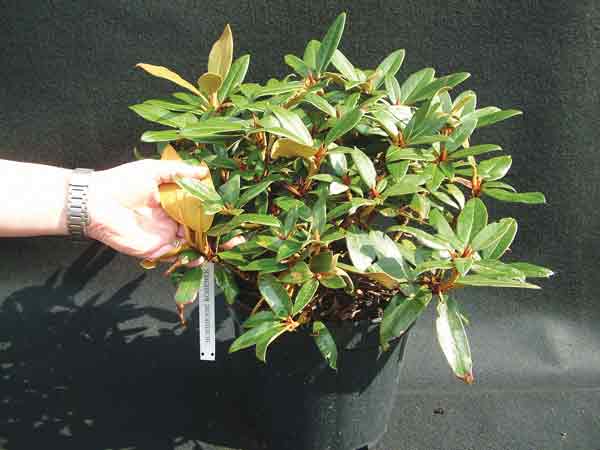
|
|---|
Fig. 7: Rhododendron hobbiense , compact form Photo by Gerald Dixon |
R. hunnewellianum (Argyrophylla). This form has medium sized, narrow, hanging foliage, smaller than most other forms and appears to be very similar to the original Wilson introduction. Hobbie was given this plant by Walter Magor and although it is no longer to be found in the Hobbie Park, there is a large example still growing in the "Forstbotanische Garten" in Bonn.

|
|---|
Fig. 8: Rhododendron hunnewellianum 'Bonn' Photo by Gerald Dixon |
R. insigne (Argyrophylla) A beautiful low-growing dense bush with stiff branches. The shiny leaves are dark green above and copper-coloured below. The Hobbie form is more free-flowering than most with compact trusses of pink with darker markings. It can be seen in the "Bunte Garten" in Moenchengladbach.
R. makinoi (Pontica). This form has very narrow re-curved leaves with pale indumentum on a compact rounded bush with light rose flowers. Less miffy than other introductions but needs to be grown in a sunny position to flower well and avoid becoming leggy. It dislikes too much warmth around the root area and should be well mulched. The plant was given to Hobbie by K. Wada of Japan. A beautiful rounded example grows in the "Bunte Garten" in Moenchengladbach.

|
|---|
Fig. 9: Rhododendron makinoi Photo by Gerald Dixon |
R. orbiculare (Fortunea). Beautiful round light green leaves on a low-growing bush with loose trusses of icing-sugar pink bell-shaped flowers. This Hobbie form has neat foliage on long, graceful pedicels and is much tougher than it looks. A perfect specimen can be seen in the garden of Christian Gutschow near Bremen.
R. oreodoxa (Fortunea). A very free-flowering upright bush with oval, light green foliage. The bell-shaped flowers are clear pink and held in loose trusses. Hobbie cultivated two forms of this species: the plant formerly known as R. haematocheilum which has neater foliage than most other forms and also R. oreodoxa var. shensiense , similar to R. oreodoxa var. fargesii but with 5 flower lobes and rufous pedicels. A beautiful tree-like specimen of R. haematocheilum can still be admired in the Hobbie Park.
R. x peregrinum (natural hybrid). Hobbie was given hand-pollinated seeds of this plant by Walter Magor who grew it as a seedling of W4254. The resulting seedlings were identical to the original plant, similar to R. galactinum in the flower but with a lighter silvery indumentum. A small group of this plant can be seen in the "Bunte Garten" in Moenchengladbach.
R. principis (Taliensia). Shiny dark green leathery re- curved foliage with a spongy whitish indumentum on a medium-sized, slow-growing shrub with rather stiff branchlets. Light pink flowers with red spotting. Early growth, so better in a position with good air drainage. This form was grown from LS&T 6645, collected during the 1938 expedition to southeast Tibet and selected by Dietrich Hobbie. Two large plants still grow in the Hobbie Park.
R. roxieanum (Taliensia). An extremely close-growing compact shrub with dark green narrow leaves with a woolly fawn indumentum on the lower surface. Flowers are white with red spotting. This form is much slower growing than other forms, barely reaching 60 cm in 20 years. Plants can be seen in Hans Robenek's garden in Linswege.
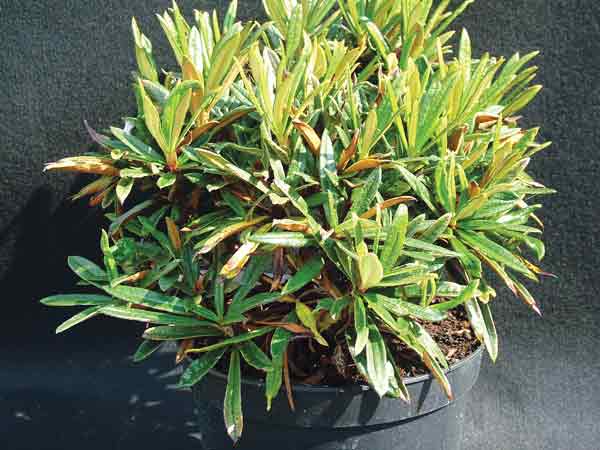
|
|---|
Fig. 10: Rhododendron roxieanum Photo by Gerald Dixon |
R. rufum (Taliensia). A medium-sized stiff-branched shrub with shiny elliptic foliage, the lower surface with reddish-brown thin indumentum. Seldom seen are its light pink funnel-shaped flowers. It is not clear where Hobbie acquired this plant but it forms a very close-growing compact shrub and is extremely tough.
R. sanguineum (Neriiflora). Loose trusses of bright crimson flowers on a rather twiggy, open-growing shrub with thinly indumented foliage. This form is particularly tough and has withstood very low temperatures. It is also unusually free-flowering.
R. taliense (Taliensia). A low-growing compact bush with dark green leathery leaves and creamy-white flowers with red spotting. The indumentum on the leaf underside is thick and tawny-brown. In full sun the leaves exude a lovely honey-like scent. This form was propagated for many years in Jan Wieting's nursery and is commonly known as the "Wieting Form."
R. traillianum (Taliensia). A compact shrub with leathery dark green leaves carrying a powdery rust-red indumentum underneath. The white-flushed-rose flowers are held in compact trusses but are rather small. This form was given to Hobbie by Lionel de Rothschild during a visit to Exbury in 1949 and is very robust and easy to grow. Large examples grow in the Rhododendronpark in Bremen.
R. traillianum var. dictyotum (Taliensia). This plant was a bit of a mystery to Hobbie. He insisted that it was a "good" Taliensia species, that it had been grown from RBG seed and could show that the seedlings were all but identical but the collector's number had been lost and he was unsure of its true identity. It forms a neat rounded shrub and is relatively free-flowering after five or six years. Material was sent last year to John McQuire, who has identified it as a form of R. traillianum var. dictyotum . Only grown in the Hobbie Park and, as far as we know, in our garden.
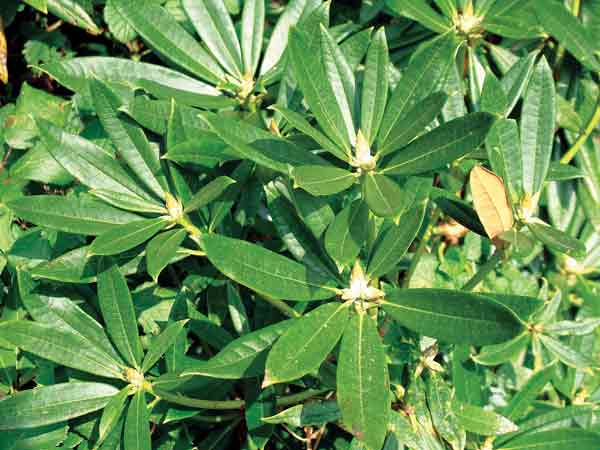
|
|---|
Fig. 11: Rhododendron traillianum var. dictyotum Photo by Gerald Dixon |
R. wiltonii (Taliensia) Given to Hobbie by Walter Magor, this form is similar to the original Wilson introduction. It forms a rounded shrub with stout branches bearing dark green bullate foliage with a loose rusty-red indumentum on the lower surface. Pink flowers with darker markings. A large bush can be seen in the "Forstbotanishe Garten" in Bonn.
R. wardii var. puralbum (Campylocarpa). This was raised from Yu 17457, received from the RBG Edinburgh in 1938. I have only ever seen one mature plant in the Hobbie Park but another good example can be seen in the woodland garden of Hayko Bruns.
R. wardii (Campylocarpa). The best form was raised from L&S 5679, and has sulphur-yellow flowers with a prominent basal flare. He also had other forms raised from KW seed but they seem not to have survived. This was possibly Hobbie's favourite species and the group of original L&S seedlings, still growing happily in the Rhododendronpark, are a beautiful sight in late June.
Dietrich Hobbie died in 1985, aged 86. His daughter Elizabeth continued to run the Park and nursery for some years, both of which have now been passed on to Hobbie's grandson, Volker. After Dietrich Hobbie's death, the species described above had been regularly propagated in the nursery of Hans Robenek. Hans had spent most of his working life as Hobbie's Head Gardener, running both the Park and Nursery, and always regarded the maintenance of the Hobbie Species as being of the utmost importance. Sadly, Hans Robenek passed away in 2005 and although there are a number of enthusiasts in Germany able and willing to continue this work privately, as far as is known no other specialist nursery is propagating these important plants.
And so we come back to the importance of public collections: luckily these are numerous enough in Germany to ensure the future existence of the "Hobbie Species."
Perhaps, we in the UK should be thinking along similar lines: we have the world's best sources as far as new species introductions are concerned and we have enough enthusiasts to organize local collections. This should surely be the main aim of our regional groups: the establishment, coordination and support of localized, properly documented plantings of rhododendrons, camellias and magnolias, including both species and hybrids. We have the initial example in our Hardy Hybrid Collection at Ramster: any volunteers, perhaps in the southwest UK, for a similar focus point, maybe for a particular species subsection or similar?
Note: Most of the information contained in this article was gleaned from conversations with Dietrich Hobbie in the early 1980s and, more so, with Hans Robenek in the ensuing years. There are many more species raised by Hobbie which are very rarely seen or no longer in propagation but hopefully more will come to light in the coming years.
Gerald Dixon is a member of the Group and the founder of Brooklands Nurseries at Shute near Axminster in Devon, UK.

